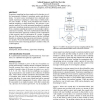Free Online Productivity Tools
i2Speak
i2Symbol
i2OCR
iTex2Img
iWeb2Print
iWeb2Shot
i2Type
iPdf2Split
iPdf2Merge
i2Bopomofo
i2Arabic
i2Style
i2Image
i2PDF
iLatex2Rtf
Sci2ools
CHI
2008
ACM
2008
ACM
Experience sampling for building predictive user models: a comparative study
Experience sampling has been employed for decades to collect assessments of subjects' intentions, needs, and affective states. In recent years, investigators have employed automated experience sampling to collect data to build predictive user models. To date, most procedures have relied on random sampling or simple heuristics. We perform a comparative analysis of several automated strategies for guiding experience sampling, spanning a spectrum of sophistication, from a random sampling procedure to increasingly sophisticated active learning. The more sophisticated methods take a decision-theoretic approach, centering on the computation of the expected value of information of a probe, weighing the cost of the short-term disruptiveness of probes with their benefits in enhancing the long-term performance of predictive models. We test the different approaches in a field study, focused on the task of learning predictive models of the cost of interruption. Author Keywords Interruption, ...
CHI 2008 | Experience Sampling | Experience Sampling ACM | Human Computer Interaction | Random Sampling Procedure |
Related Content
| Added | 30 Nov 2009 |
| Updated | 30 Nov 2009 |
| Type | Conference |
| Year | 2008 |
| Where | CHI |
| Authors | Ashish Kapoor, Eric Horvitz |
Comments (0)

